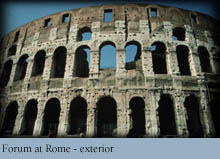
The assasination of Julius Caesar in 44 BCE led to a power struggle in Rome between Marc Antony and Octavian, Caesar's nephew. In 31 BCE Octavian defeated the combined forces of Antony and Cleopatra at the battle of Actium. As a result, Egypt was made a province and Octavian took the title of Augustus, the first Emperor. Thus commences the Imperial Period of Rome, which would last to the fifth and sixth centuries CE, when it would enter the medieval period in the Latin west and the Byzantine period in the Greek east.
During the late Republican period and throughout the Imperial period the city of Rome became not only the capital of the Empire but also its biggest and most spectacular urban center. Legend holds that the city was founded by Romulus, descendant of Aeneas of Troy, in ca. 732 BCE. The archaeological evidence indicates that there was a small settlement on the site from as early as the 9th century BCE. At first a small settlement nestled in the valleys between the Palatine and Capitoline hills near the Tiber river, the city grew by conquest of and intermarriage with neighboring clans. By the 7th century the marshy land between the hills was cleared and served as the market center of the town. This area came to be known as the Forum and the drainage system, the Cloaca Maxima. By the fourth century BCE the city was enclosed with a defense structure, the Servian Wall, measuring over 10 feet thick. The highway system leading into Rome and the first aquaducts for bringing water into the city were begun by the end of the fourth century. The political expansion of Rome's power through Italy and elsewhere in the Republican periuod resulted in further expansion of the city. The forum was expanded and added formal architectural definition, new tempels were built both in the forum and in the Largo Argentina area, and the Capitoline hill (overlooking the Forum) became the religious center of the city. The Tiber and the city's waterfront areas were developed for the shipping industry.
After the civil wars of the firts century BCE and with the rise of Augustus, the city was rebuilt on an even more monumental scale. While always paying hommage to the traditions and customs of the past, Augustus gave the new Rome a new luster and aesthetic dimension. He also coopted many of the traditional sanctuaries and festivals to him imperial ideology, often encapsulated in the slogan, Pax Romana (—The Peace of Romeś) or Pax Augusta (—The Augustan Peaceś). The summit of the Palatine hill was the site of the imperial palace, and it communicated directly with the Forum and the Capitoline by a series of paths. In addition he initiated new imperial building programs, including the Forum Augusta, alongside the earlier Forum (usually called the Forum Romanum). Subsequent emperors would follow suit by adding their own fora and public works programs for the good of the city and the glory of the emperor. For example, the Colosseum (or Flavian amphitheater) was begun by the emperor Vespasian and dedicated under his son Titus, in the year 81. Vespasian had been the general in charge of the Roman armies in the early years of theJewish revolt, and he was succeded by Titus when he became emperor in 69. On Titus' victorious return to Rome in 72, Vespasian dedicated the triumphas arch to Titus that now serves as one of the main entrances into the Forum. Among its reliefs depicting Titus' accomplishments is the famous, and poingant, scene of his soldiers carrying the great Menorah away from the Temple in Jerusalem at the end of the Jewish War.
Finally, by the first century Rome had grown to something just under a million people. It was a huge, complex, and diverse city. By the end of the first century it would play host to many enclaves of foreigners, including Jewish and Christian groups. Most of these congregations seemed at first to reside in outlying areas of the city. Jews and Christians initially favored the new area of urban sprawl across the river (the ¬trans-tiberine' and now called Trastevere) from the old city. By the third and fourth centuries, however, Jewish and Christian groups were spread throughout the city's various districts. On the basis of archaeological evidence, largely from the several Jewish catacombs (or cemeteries), it appears that there were ten different Jewish congregations in the city. By the time that Christianity had become legitimate, after the victory of Constantine in 313, there were a number of Christian congregations in the city. Some of these are still associated by legend, and partially confirmed by archaeological evidence, with some of the oldest church buildings still present in the city. These include especially the churches of San Clemente, Saints John and Paul, San Chrysogono, all of which reflect pre-Constantinian building levels.
With the victory of Constantine new imperial building projects would begin to develop new churches and Christian landmarks; these include the Church of St. John Lateran (originally an imperial palace), which became the seat of the bishop of Rome and the Vatican (originally the circus of Nero and an adjacent cemetary), which became a memorial basilica dedicated to St. Peter.